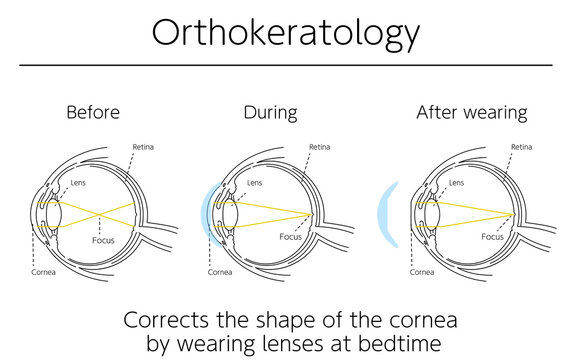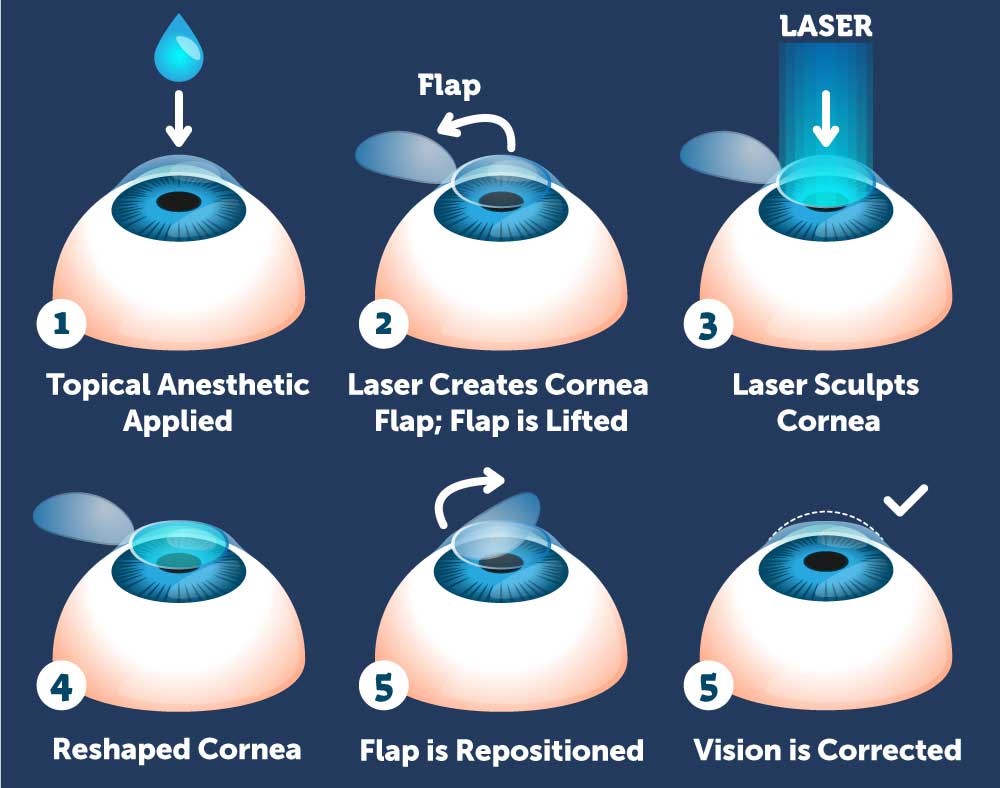Orthokeratology and LASIK are two common vision correction procedures that aim to reduce or eliminate the need for glasses or contact lenses. While both procedures reshape the cornea to improve vision, they work in different ways [1].
Orthokeratology, also known as ortho-k or corneal refractive therapy, involves wearing rigid gas-permeable contact lenses while sleeping to temporarily reshape the cornea [2]. The rigid contact lenses are specially designed to flatten the cornea, which reduces nearsightedness or myopia. This effect lasts during the day once the contact lenses are removed upon waking, thereby improving vision without glasses or contacts during waking hours [3]. The cornea gradually returns to its original shape when not wearing the lenses at night. Orthokeratology provides a reversible and non-surgical way to correct mild to moderate nearsightedness, though effects may diminish with time [2].

LASIK (laser-assisted in situ keratomileusis), on the other hand, is a surgical procedure that uses an excimer laser to permanently reshape the cornea [4]. During Modern LASIK, a laser is used to create a thin flap on the surface of the cornea, which is folded back to expose the stromal layer underneath. The excimer laser then ablates or vaporizes small amounts of tissue to flatten the cornea and correct refractive errors like nearsightedness, farsightedness and astigmatism. The corneal flap is then replaced, allowing it to heal without stitches in a few days [5]. Unlike orthokeratology, the cornea retains its new shape after LASIK. It is designed to provide a permanent way to reduce dependence on glasses or contacts by surgically altering corneal curvature.

While both orthokeratology and LASIK effectively improve vision for many patients, there are notable differences between the two procedures:
- Orthokeratology is a non-surgical procedure, while LASIK is a minimally invasive surgical procedure requiring the use of numbing drops only (no general anesthesia is used) [1,4].
- Orthokeratology effects are temporary and reversible, only lasting during lens wear, whereas LASIK results are intended to be permanent [2,5].
- Orthokeratology can only correct mild to moderate nearsightedness, while LASIK can treat wider ranges of nearsightedness, farsightedness, and astigmatism [2,5].
- Orthokeratology has quicker recovery, with vision improving in the first night of lens wear. LASIK patients will immediately noticed improved vision with optimal results being seen after several days of healing [2,4].
- Orthokeratology is less expensive than LASIK initially, but the cost of purchasing the required contact lenses long-term (annually is recommended) should be considered. The cost for Othokeratology lens fitting and supplies is around $1000-$2000. According to the American Refractive Surgery Council, the average cost of LASIK in 2022 was $2,246 per eye, does vary depending on the clinic, surgeon, type of LASIK procedure, and other factors [2,5,6].
- Orthokeratology is approved for overnight use in children, while LASIK is only approved for patients 18 and older [3,5].
- Patients undergoing orthokeratology require regular lens replacement and eye exams to maintain effects. LASIK aims for stable, lifelong results without continued treatment [2,4].
In summary, orthokeratology provides a reversible way to temporarily correct mild to moderate nearsightedness without surgery using gas-permeable contact lenses worn at night. LASIK surgically reshapes the cornea for permanent vision correction but is a surgery and the risks, albeit small, should be considered. The optimal choice depends on the degree of vision correction needed and the patient’s lifestyle, eye health, and willingness to undergo surgery. Patients with nearsightedness interested in reducing dependence on glasses or contacts benefit from consulting with an eye doctor to determine if they are candidates for either procedure. For patients struggling with farsightedness or astigmatism, Orthokeratology is not an option, while LASIK corrects nearsightedness, farsightedness, and astigmatism.
References
[1] Cho, P., Cheung, S. W., Edwards, M. (2005). The longitudinal orthokeratology research in children (LORIC) in Hong Kong: a pilot study on refractive changes and myopic control. Current Eye Research, 30(1), 71–80.
[2] Bullimore, M. A., Sinnott, L. T., Jones-Jordan, L. A. (2013). The risk of microbial keratitis with overnight corneal reshaping lenses. Optometry and vision science : official publication of the American Academy of Optometry, 90(9), 937–944.
[3] Walline, J. J., Jones, L. A., Sinnott, L. T. (2009). Corneal reshaping and myopia progression. The British journal of ophthalmology, 93(9), 1181–1185.
[4] Sugar A. Ultrafast (femtosecond) laser refractive surgery. Curr Opin Ophthalmol. 2002;13(4):246-249.
[5] Ziaei M. Long-term results of an FDA approved LASIK surgeon using the ALLEGRETTO WAVE Excimer Laser Platform.J Refract Surg. 2021 Jan 1;37(1):29-34.
[6] American Refractive Surgery Council’s 2022 survey of LASIK surgeons: https://www.americanrefractivesurgerycouncil.org/lasik/how-much-does-lasik-cost/



